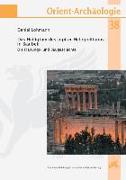- Start
- Lohmann, D: Heiligtum des Jupiter Heliopolitanus in Baalbek
Lohmann, D: Heiligtum des Jupiter Heliopolitanus in Baalbek
Angebote / Angebote:
Die Publikation des Jupitertempels ist für das übergreifende Forschungsprojekt zur Entwicklung von Heliopolis / Baalbek von besonderer Bedeutung und konzentriert sich auf Planungsabschnitte und tatsächlich ausgeführte Bauabschnitte. Dazu wurde neu erschlossenes Archivmaterial ebenso genutzt wie stratigraphische Beobachtungen und eine Ergänzung der Bauaufnahme um unbekannte Bereiche. Es ergaben sich fünf Bauphasen auf der Grundlage von vier Planungen. Mehrere Fehldeutungen und Fehldatierungen konnten behoben werden. Der seit der Gründung der Kolonie Beirut 15 v.Chr. in Bau befindliche Tempel wurde wohl unter Domitian geweiht, dessen Planungen für die berühmten "Superlative" sorgten. Seit Hadrian folgte der Altarhof, um 200 n.Chr. der Hexagonalhof. Es wurden orientalische, hellenistische und römische Einflüsse festgestellt. Eine prägende Rolle spielten Wasser und Fruchtbarkeit in Form der nahen Quellgebiete von Orontes und Leontes, deren Kontrolle Rom beanspruchte. Wesentliche Leitmotive waren ehrfurchtgebietender "Megalithismus" und die Staffelung von Baukörpern für eine bühnenartige und in die Höhe führende Inszenierung des Kultgeschehens.
The publication of the Temple of Heliopolitan Jupiter is of outstanding importance for the interdisciplinary research project on the development of Heliopolis/Baalbek and focusses on the planning phases and the building stages that were actually implemented. The study is based on previously unconsidered archive material, stratigraphic observations, and a supplementation of construction surveys by unknown areas. This revealed five building phases based on four planning stages. Several misinterpretations and misdatings have been corrected. The temple initiated with the foundation of the colony of Beirut in 15 B.C., was probably dedicated under Domitian whose design provided for the famous "superlatives". Since the reign of Hadrian, the altar court started to be added, and the hexagonal court followed by 200 A.D. There is evidence for oriental, Hellenistic, and Roman influences. A major role was played by water and fertility in the shape of the nearby sources of the rivers Orontes and Leontes / Litani whose control was claimed by Rome. Important leitmotifs were the awe-inspiring "megalithism" and the staggered architecture for a stage-like and rising arrangement of ritual procedures.
Libri-Titel folgt in ca. 2 Arbeitstagen
